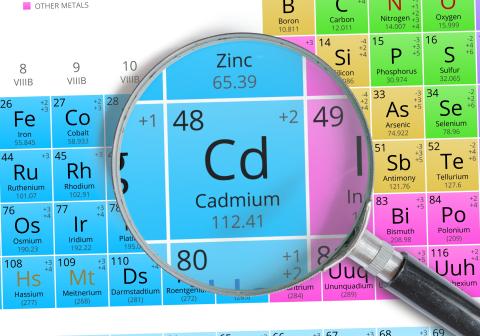Cadmium
What is cadmium?
Cadmium is a naturally occurring metal that is found in all soils and rocks. Cadmium can enter the air through mining during the smelting process, as well as through the burning of coal or municipal waste.
Cadmium is used in many consumer products including batteries, pigments, and metal plating.
How can I be exposed to cadmium?
People can be exposed to cadmium from air, drinking water, and food.
Air
Smoking tobacco and second hand smoke are major sources of cadmium exposure. This is because tobacco plants can easily take up and accumulate cadmium. Cadmium exposure may also occur from the use of smokeless tobacco products such as chewing tobacco.
People who work in or live near places that use cadmium, process metal, or burn coal can be exposed to cadmium in air.
Drinking water
People who live near places where cadmium is used or was spilled or disposed of in the past can be exposed to cadmium from drinking water.
Food
Cadmium occurs naturally at low levels in many foods. In most cases, these foods do not pose a health risk. Cadmium is most commonly found at low levels in mushrooms, leafy vegetables, root crops, cereals, and grain, meats, and shellfish.
How can cadmium affect my health?
Breathing high levels of cadmium in a short period of time can severely damage the lungs. Eating food or drinking water with very high levels in a short period of time severely can irritate the stomach causing vomiting and diarrhea.
Long-term exposure to lower levels of cadmium in air, food, or water causes cadmium buildup in the kidneys and an increased risk of kidney disease. Other long-term effects are lung damage and fragile bones.
How can I protect myself from cadmium?
If you smoke commercial tobacco avoid smoking in the house, in enclosed areas, and near children.
Check our help to quit page for resources on overcoming tobacco addiction.
If you work with in a place that uses cadmium, processes metal, or burns coal:
- Read and follow instructions provided by your employer.
- Wear all required personal protective equipment (such as gloves, masks, coveralls, and respirators).
- Shower or change clothes before leaving work to avoid bringing chemicals home with you. If this is not possible, change as soon as you get home and wash your work clothes separately from the rest of you and your family’s laundry.
If you live near a place where place that uses cadmium, processes metal, or burns coal:
- Email DHS staff at DHSEnvHealth@dhs.wisconsin.gov to learn what is being done to address the contamination.
- Call 911 if you smell very strong chemical odors in your home.
Public water users
Community water systems are required to test for cadmium on a regular basis. If the level of cadmium is above Wisconsin's drinking water standard, your water system will issue a public notice.
The public notice will include information on the levels detected, the actions that the system is taking to address the problem, and any steps that you should take to reduce your cadmium exposure.
Private well users
Test your well for cadmium at least once.
Complete a metals panel using a Wisconsin certified lab.
If the cadmium level equals or is greater than 5 micrograms per liter (µg/L), use a different source of water for drinking and preparing foods that take up a lot of water. Options include include bottled water, water from a well without issues, and water from a public system without violations.
Find a long-term solution. Options include installing a certified treatment device and drilling a new well.
Our Water Treatment Devices for Private Well Contaminants fact sheet, P-45012, has information on common certified treatment devices and instructions for how to find them.
The Wisconsin Department of Natural Resources (DNR) well compensation grants provide funds to address public health hazards in private wells.
Eat a well balanced diet to reduce the amount of cadmium taken into the body from food and drink.
Our Nutrition and Food Assistance page has information about programs that help with access to healthy foods.
Follow Wisconsin's fish consumption advisories to reduce cadmium exposure from fish and shellfish.
The DNR's Eating Your Catch—Making Health Choices page has an online query tool that allows you to look for advisories based on waterbody name and location.
Who regulates cadmium?
DNR regulates how much cadmium can be released into the air, surface water (lakes, rivers, and streams), and groundwater in Wisconsin.
DNR regulates how much cadmium can be in water served by public water systems and oversees the clean up of contaminated sites.
Related topics
Our groundwater standards page has information on how Wisconsin's groundwater standards are set, DHS' role in the process, and a summary of the current and recommended standards, including cadmium.
The DNR's Bureau of Remediation and Redevelopment Tracking System on the Web (BRRTs on the Web) provides information on contaminated properties and other cleanup and redevelopment activities in Wisconsin including cadmium sites.
The Agency for Toxic Substances and Disease Registry's ToxFAQs page has more information on cadmium exposure routes and health effects.

